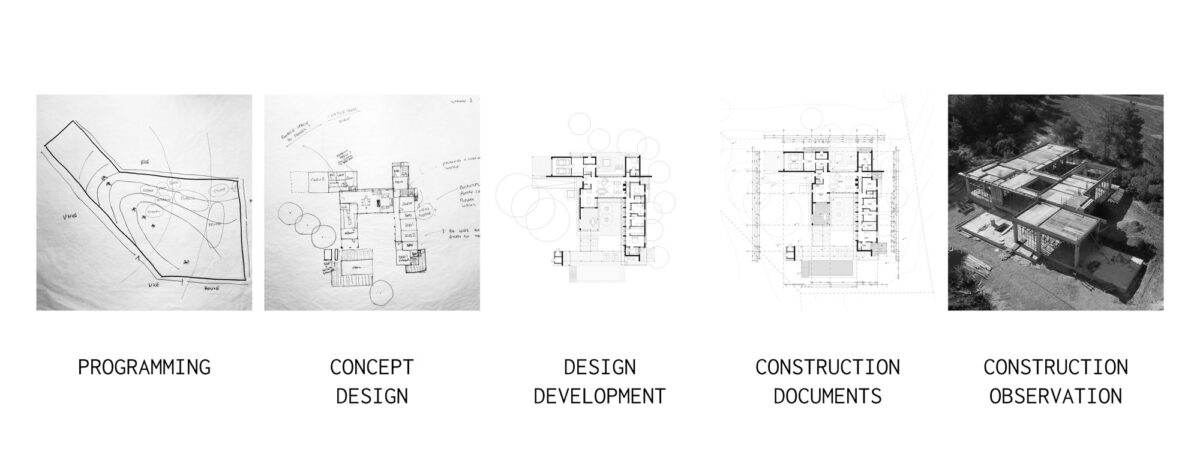
DESIGN PROCESS
A GUIDE TO WORKING WITH SQUARE 61 STUDIO
Hey there,
In the last post, How and why architects organise their projects (Part 1) I talked about general terms why we organise our work. In this post I will explain in detail the American AIA system that I use for most of my international projects.
As every architectural plan of work is by nature linear, although it’s worth noting how we arrive at the final design isn’t always linear.
The design process is iterative and results in a unique product tailored to your needs. Custom design is thrilling because it’s a collaborative journey where we create something together based on your specific requirements. By following this process, you’ll have a carefully crafted home and the shared experience of designing it.
Architects typically follow a similar set of steps to complete a building design. These steps can be broadly categorised into six phases.
Phase 1 Predesign – site analysis, programming, existing conditions, budgeting, code review.
Phase 2 Schematic Design – basic design concept generation
Phase 3 Design Development – refinement of the selected design concept from phase 2
Phase 4 Construction Documents – detailed drawings, schedules and specs
Phase 5 Contractor Selection – aid in contract award / negotiation with GC
Phase 6 Construction Observation – oversee construction + administration of the contract.
Phase 1: Predesign
This is essentially an information gathering and processing phase – what I do before I start design. We collect all the information about the project to use in schematic design. This includes information about the site, any existing structure(s), codes, deed restrictions, septic information, site utilities, access, budget, questionnaire and schedule.
Phase 2: Schematic Design
In this phase, the foundational ideas of the project begin to take form. Based on earlier research and discussions, several initial design options—typically two or more—are developed for review. A project narrative is also created to provide a clear conceptual direction that informs all future design decisions.
Designs are presented in a loose and exploratory way—through sketches, diagrams, and early models (either physical or digital). These are not finalized drawings but rather tools to explore possibilities, spark discussion, and invite feedback.
Through collaborative review and discussion, one preferred concept is selected—sometimes combining elements from multiple options into a hybrid design. This chosen concept becomes the base for more detailed development in the next phase.
By the end of this stage, the following are typically produced :
- Concept Site Plan
- Concept Floor Plan
- Sketch Elevations
- 3D model
- Preliminary Cost Estimate
Phase 3: Design Development
This phase transitions from early conceptual sketches to more precise and technical digital drawings. The schematic design is refined to define the exact location of the building on the site, taking into account the topography and how it shapes the building’s form.
Detailed floor plans are developed, showing walls, doors, windows, and staircases, along with accurate room dimensions and spatial relationships. The building’s volume and initial exterior elevations are also established. A preliminary material palette is explored, setting the tone for interior and exterior finishes, though detailed specifications will come later.
Key building systems begin to take shape, including structural components, mechanical layouts, heating and cooling strategies, lighting concepts, and other technical systems.
Consultant Involvement
This stage also marks the beginning of collaboration with specialized consultants. Structural engineers are typically engaged to ensure the building meets performance standards and can withstand site-specific forces such as wind or seismic activity. Depending on the project’s needs, additional consultants—such as landscape architects, lighting designers, or mechanical engineers—may also join the team to contribute their expertise.
At phase completion, there will be a set of drawings for what looks like a house, but not quite enough to build from. At the end of this phase we will usually have the following :
- Site / Grading Plan
- Floor Plans 1:200
- Exterior Elevations 1:200
- Sections
- Interior Elevations
- Outline Specification
- Structural Concept
- Lighting Concept
- Mechanical Systems Concept
Phase 4: Construction Documents
This phase involves producing a complete and detailed set of drawings and written specifications that describe every aspect of the building. These documents serve as the official guide for pricing, permitting, and construction—essentially functioning as the project’s instruction manual.
At this point, a decision is made about how to proceed with construction pricing—either through competitive bidding or a negotiated contract with a selected contractor.
For a typical project, the following documents are prepared:
- Site Plan
- Floor Plan(s)
- Foundation Plan
- Exterior Elevations
- Building Sections/Wall Sections
- Door + Window Details
- Interior Elevations
- Details (interior/exterior)
- Electrical / Lighting plans
- Building Specifications
- Schedules (Door/Window/Hardware/Plumbing/Lighting/Finish/Appliance, etc.)
- Structural Plans
Initiation of the project’s submission for local permitting early in this phase, allows any required adjustments to be incorporated before finalising the drawings. While the local permitting process is generally uncomplicated, it can be time-consuming. For complex sites, it might be necessary to begin the permitting process earlier, a decision typically made during the Predesign phase.
During the construction documents phase, clients involvement will be reduced as most decisions will have been finalised.
Phase 5: Contractor Selection (Bidding or Negotiated)
This is a separate phase, but it typically occurs alongside other phases of the work, especially if the contractor you’re seeking is in high demand. There are typically two means of selecting a contractor – by competitive bidding or by negotiated contract.
Phase 6: Construction Observation
During this phase, the construction of the project is underway and closely monitored to ensure that it aligns with the design intent and contract documents. Regular site visits are conducted to observe the quality of work, track progress, and address any issues that arise.
This stage involves ongoing communication between the contractor, subcontractors, and the architect to clarify details and maintain consistency with the original plans. Unforeseen challenges or conditions that couldn’t be fully anticipated during the design phase are addressed here, with adjustments made to preserve both function and aesthetics.
Key documentation like payment applications, change orders, and clarification sketches are reviewed and processed. Toward the end of construction, a detailed inspection takes place to identify any remaining work or deficiencies, which are compiled into a punch list.
The phase wraps up with the resolution of all outstanding items, final inspections, and certification of project completion—ultimately delivering a finished, ready-to-occupy building.
Summary
The architectural design process is both structured and creative, unfolding through six key phases that transform initial ideas into a fully realised building. It begins with gathering essential information in the Predesign phase, followed by exploring possibilities during Schematic Design. The chosen concept is then refined and detailed in Design Development, laying the groundwork for the comprehensive Construction Documents needed for permitting, pricing, and building. In Contractor Selection, the right builder is chosen to execute the vision, either through bidding or negotiation. Finally, Construction Observation ensures that the design is faithfully and accurately brought to life on site. While these phases follow a logical order, the process is inherently iterative—shaped by collaboration, adjustments, and evolving ideas—resulting in a custom-built home that reflects your specific goals and needs.
Stay tuned and catch you later,
Jarek Karpik
